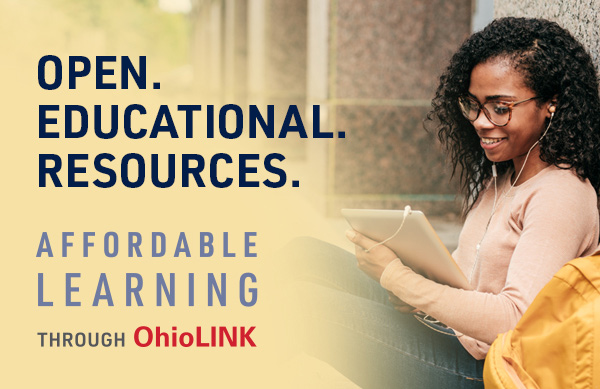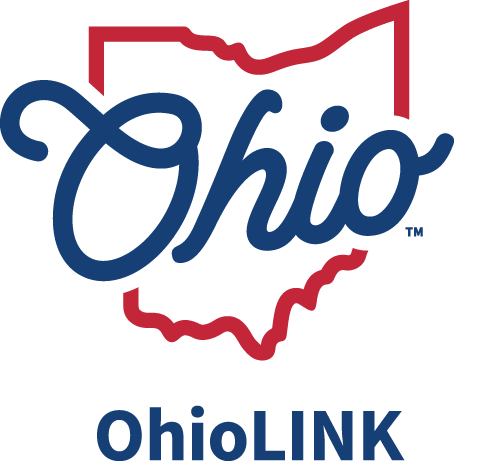As part of its third annual OhioLINK Membership Summit, OhioLINK recently hosted the “What COVID-19 Taught Us About Affordable Course Materials” panel, which discussed lessons learned about using affordable course materials in the rapid transition to online learning during the pandemic.
Following a brief introduction from Anna Bendo, OhioLINK’s Director of Affordable Learning, panelists were each given time to discuss their experience working on affordable learning projects that were in part spurred on by the COVID-19 pandemic. Afterwards, speakers were asked several questions regarding how the pandemic affected their work, whether faculty and staff at their institutions became more agreeable to utilizing Open Educational Resources (OER) materials, and how they think affordable course materials will fare in post-pandemic life.
A common sentiment among the speakers was that faculty and staff were incredibly overwhelmed with the transition to online courses, and while OER materials are helpful during such a pivot, they can also seem daunting to incorporate.
“Like many libraries, when the pandemic started, we had a lot of faculty who were suddenly having access issues that they didn’t before or were becoming aware of their students’ access issues that had already existed,” said Mandi Goodsett, performing arts & humanities librarian and open educational resources & copyright advisor at Cleveland State University. “The first strategy was to try and provide increased access to e-books for our faculty … and our second strategy was to provide faculty support and training specifically for adopting open educational resources or library-licensed content.”
To encourage instructors to engage with OER resources, some institutions such as Miami University began offering consultation services.
“We had five people go through the course pack consultation, and we were able to make 100% of their course packs freely available online to students,” said Carla Myers, assistant librarian & coordinator of scholarly communication at Miami University.
On top of providing consultation services for instructors and working hand-in-hand to show them how easily affordable resources can be incorporated into classes, panelists observed that faculty desired some sort of compensation for the time it takes to complete the process.
“Faculty would like to see some kind of financial incentive for their extra efforts, and it shows how valuable their work is in supporting our students,” said Lindsey Mason, director of faculty services, Ohio Dominican University. “So, we started brainstorming a solution to both the time and money issues. We came up with a one-day workshop hosted by both librarians and instructional designers. We learned that this time issue could be greatly mitigated by having that dedicated day with active support throughout the day. And then for the financial incentives, we were approved to use CARES Act funding to provide stipends that we’ll be paying our faculty.”
While discussing her experience with OER resources in the classroom before and during the pandemic, Anna Davis, associate professor and mathematics department head for Ohio Dominican University, noted how these resources helped her introductory statistics students stay successful, even with having to switch testing and homework to an online format.
“After examining the data for the first half of this semester between four sections pre-pandemic and three sections during the pandemic, what we found is that there was no significant difference in student averages,” Davis said.
On the community college front, Pamela Ratvasky, instructional designer at North Central State College, has spent the past year educating other community colleges on how they can access OER materials and to clarify some of the misconceptions they may have.
“The more I learned (about OER), the more I became excited to be an advocate for it … So far, I’ve gone to about nine different community colleges,” Ratvasky said. “Right now at North Central we have in the mix about 30 classes that are in the process of implementing OER materials.”
As libraries and institutions across the country look forward to what academic life looks like after the pandemic, it is clear that decisions made regarding OER during COVID-19 will continue to impact future initiatives and prepare academics if another instance occurs in which remote school and work is necessary.
“I am not the one choosing materials, but I think if I were that I would always have in the back of my mind, ‘How would this work if this happens again? Would these materials be accessible if all of a sudden we have to go home next week?’ So, I feel like for everyone, our perspective has shifted to thinking about what happens if we’re back in that mode,” Bendo said.
3 Actionable Takeaways from Panelists:
- Problem-solve with affordable learning peers across Ohio through OhioLINK’s Affordable Learning listserv. If you aren’t already a member of this listserv, contact support@ohiolink.edu.
- Consider offering “course-pack consultations” to show faculty what’s possible and make the transition less daunting
- Address faculty time and compensation concerns by hosting a faculty workshop with active support that results in a concrete takeaway, i.e., an open resources list that fits course objectives or helps with a course redesign using OER
"While no one would wish for the kind of forced shift to online instruction that the pandemic created, it did push instructors to teach with electronic resources and to consider low- and no-cost alternatives for course materials," said Ohio Department of Higher Education Chancellor Randy Gardner. "This ‘trial by fire’ experience will continue to influence textbook choices, and we are thankful that OhioLINK and its Affordable Learning Ambassadors are sharing best practices to support Ohio higher educators as they investigate the transition to more affordable course materials."
The June 1 webinar was part of the OhioLINK Summit, an annual meeting that connects staff from OhioLINK member institutions and provides the opportunity for participants to share ideas, brainstorm future initiatives and reflect on the past year’s accomplishments. Due to COVID-19, the OhioLINK Summit has adapted to an online format. Nine webinars will be held May through August.
If you are interested in upcoming OhioLINK Summit webinars, please visit OhioLINK’s member extranet for the full schedule (log-in required).
About OhioLINK: Connecting libraries, learning and discovery
Established in 1992, the Ohio Library and Information Network (OhioLINK) is Ohio’s statewide academic library consortium, serving 88 institutions plus the State Library of Ohio. Delivering both IT infrastructure and content negotiation, OhioLINK provides students, researchers, faculty, and staff with access to valuable digital research collections at a fraction of the cost if those collections were purchased by individual institutions. OhioLINK also connects library services, print and digital collections among its member institutions and manages collaborative services aimed at reducing students’ cost of higher education in Ohio, including eTutoring and Affordable Learning. A member of the Ohio Technology Consortium of the Ohio Department of Higher Education, OhioLINK creates a competitive advantage for its member institutions and supports student and researcher success across Ohio. Learn more at ohiolink.edu.

